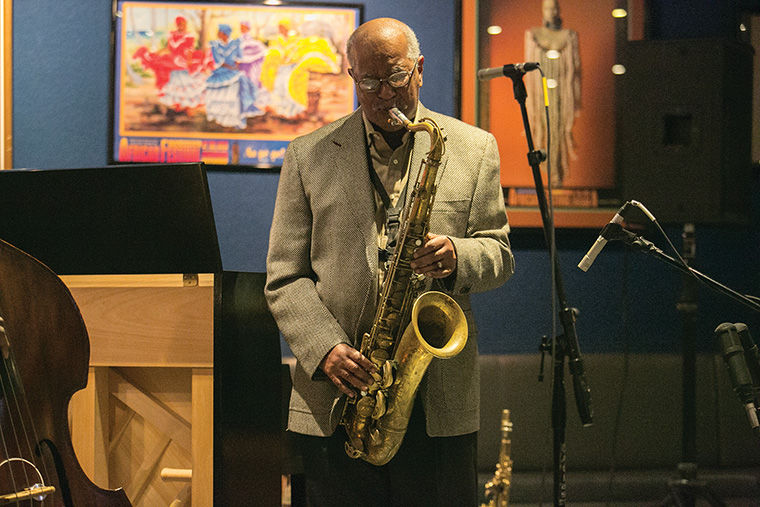Ari Brown double set jazzes up Café Logan
Jazz saxophonist Ari Brown and bassist Yousef Israel play at Café Logan in Hyde Park, 915 E. 60th St., for a taped broadcast for Chicago jazz radio station 90.9FM WDCB. Brown and Israel played two sets that night.
November 24, 2014
Many of the jazz greats have died, leaving their records as the only way fans can keep their work alive. However, that is not quite the case in Chicago, where native multi-instrumentalist Ari Brown, 70, played a two-part set with bassist Yousef Israel on Nov. 18 at Café Logan, 915 E. 60th St.
Over the years, many legends have graced the stages of dimly lit, smoky jazz lounges. In the late 1940s and the early 1950s, Charlie “Bird” Parker and Dizzy Gillespie created bebop and changed the way musicians played jazz for the rest of time. Jazz artists such as Pharoah Sanders and Sun Ra helped turn jazz into a cosmic force of experimental textures—jazz that is felt and not heard. Brown is a modern example of the spectacle of pure musical expression that is live jazz.
The set, which was being recorded for a later broadcast by Chicago’s 90.9 FM WDCB station, started with Brown playing a soft number on the flute, an instrument not often associated with the musician known for his saxophone and piano playing.
Brown and Israel’s set took off when the pair played Brown’s rendition of the jazz standard “In a Sentimental Mood” composed by Duke Ellington. The pair only played a handful of notes before the crowd recognized the classic and began to applaud. Like any talented musician should, Brown made the song—which appears on his 2013 album Groove Awakening—his own. Brown’s version is somber, inspiring soft sways from audience members, most of whom sat just in front of him. However, Brown breathed life into the tune with his fast-paced gallops from note to note, mimicking the style of John Coltrane, who played with Ellington on the most popular recording of the song.
Brown then altered the mood by playing some of his own material, such as “3bop 4 Mal,” which showcases the post-bop playing style Brown uses with his quintet. Such songs called for a string of solos from both Brown and Israel, at times converging into dual freestyles. Israel would travel up and down the fret board of his double bass, sometimes passing it for a tight ping sound. Meanwhile, Brown would take off into another solo, shaking his shoulders and grooving to his own tune, fingers flailing about the keys almost too fast for the sound to escape.
The second set of the night continued in a very similar fashion—with the exception of two songs—with Brown at the piano combining the sounds of a symphonic pianist and the pounding chords of Thelonious Monk. Aside from the break between sets, Israel acted as the backbone of the performance, and there was hardly a moment when he was not plucking his double bass.
Brown completed the double set with “Rahsaan in the Serengeti,” playing both a tenor saxophone and soprano saxophone at the same time, something he is known well for doing, which commanded many cheers from the audience. With a saxophone in both hands, Brown made the golden wind instruments flutter and wail, matching the cheers coming from the seated crowd at Café Logan.
Brown and Israel walked out and greeted their crowd after the set, shaking hands and giving hugs to certain members of the audience, showing that Brown is still very much in touch with his Chicago roots.
A two-piece arrangement is not commonplace, but Brown and Israel proved that two is more than enough to get the job done and that great jazz can still be seen live today.
Brown’s show was part of a series at Café Logan held the third Tuesday every month.








